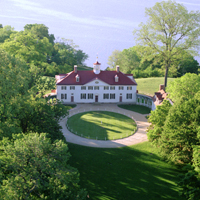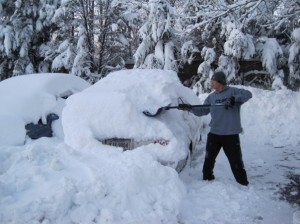 Mount Vernon, Virginia -- The Donald W. Reynolds Foundation has pledged $38 million to Mount Vernon, the home of George Washington, to construct a new library destined to be the international headquarters for knowledge about America’s most famous founding father.
Construction of the 45,000 square foot facility, which will be named the Fred W. Smith National Library for the Study of George Washington, is expected to begin in early 2011, with a completion date in 2012. The facility will be tucked into the woods across from Mount Vernon’s conservation complex and within walking distance of the Mansion itself.
As the nation’s first and only center for amassing and disseminating knowledge about Washington, the Fred W. Smith National Library for the Study of George Washington will safeguard Washington’s books and manuscripts, serve as a scholarly retreat, create educational outreach programs on Washington, and provide seminars and training programs with a special focus on Washington’s leadership.
As the longtime chairman of the Donald W. Reynolds Foundation, Fred W. Smith has championed a number of projects related to George Washington, including the purchase of the famous Lansdowne portrait of Washington by Gilbert Stuart for the Smithsonian’s National Portrait Gallery. In addition, under Smith’s leadership, the Foundation has supported the construction of a museum and education center at Mount Vernon, a pair of major traveling exhibitions about Washington, and special programs focusing on Washington for students and teachers across the nation.
“I am pleased and humbled that my fellow trustees have approved the award of this grant and the naming opportunity in my honor,” stated Smith. “It is our hope that this new facility will be a tool that the staff at Mount Vernon and Washington scholars can use to keep his place in American History as not only the Father of our Country but arguably our greatest president of all time.”
The Foundation’s gift is the largest in the history of Mount Vernon, which ranks as the oldest and most visited national preservation project in America. The Mount Vernon Ladies’ Association, which purchased the estate from the Washington family in 1858 and opened it to the public in 1860, is unusual in that it receives no funds from the local, state, or federal governments.
“Fred Smith and the Donald W. Reynolds Foundation have enabled us to remain a leader among historic sites around the globe, without calling upon the government for help,” noted Boyce Ansley, Regent of the Mount Vernon Ladies’ Association. “Mount Vernon is a totally different and far more exciting educational experience because of their support.”
The idea for a facility that serves the role of George Washington’s presidential library is not a new one—it has been part of Mount Vernon’s master plan for several years. Although Washington continues to be one of the most familiar faces in American history, numerous surveys and focus groups have revealed that a majority of Americans—particularly those in younger generations—know little about Washington’s achievements or personality. Coverage of Washington in many history textbooks has declined to about 10 percent of what it was 50 years ago. When one state’s high school students were recently asked the question, who was America’s first president, only 26 percent identified “George Washington” as the right answer.
Most American history scholars generally rank Washington as one of the nation’s three most important presidents, along with Abraham Lincoln and Franklin D. Roosevelt. “Few scholars would argue that Washington’s leadership and character still sets the gold standard,” noted James Rees, President of George Washington’s Mount Vernon. “He remains a very relevant role model, particularly as the nation faces a challenging time in its history.”
Although The Fred W. Smith National Library for the Study of George Washington will house hundreds of manuscripts, books and other documents drafted and owned by Washington, the complete array of Washington’s written works, which number in the tens of thousands, are spread among collectors, both public and private, across America. But Mount Vernon’s library will bring them all together in a complete digital record of letters to and from Washington, assembled by scholars at the University of Virginia over a period of some 40 years. All the records related to The Papers of George Washington project will be transferred to the library at Mount Vernon when the last of approximately 90 volumes of letters is edited, roughly 15 years from now.
Until then, the library will provide a secure and environmentally friendly home to 45 books from Washington’s original library, as well as 450 letters and other manuscripts written in his hand. The collection also includes approximately 1500 additional 18th-century books, as well as thousands of important 19th-century newspapers, manuscripts, and documents. The bulk of the library stacks will be filled with modern books about Washington and the founding era, which will be made available to a much wider constituency.
Historians and authors will have a far easier time accessing the information in Washington’s writings, and Mount Vernon will more than double its library staff to provide expertise and assistance. Serious researchers who are drafting articles, papers or books about Washington will be lodged in a convenient guest house adjacent to the Library, equipped with six bedrooms.
Simultaneously, the Mount Vernon Ladies’ Association hopes to create a Mount Vernon Press, which will publish new research on Washington, his family and his times, in both printed and digital versions.
A team of education and media experts will also move to the new Library, charged with the task of disseminating the research findings to the largest and most diverse audiences. To accomplish this goal, the Association will form partnerships with universities, state school systems, patriotic societies, technology firms, movie producers, computer game creators, and others from both the public and private sectors.
The Library will also host small and medium-sized conferences and symposiums focusing primarily on leadership training. Five meeting spaces will accommodate between 15 and 100 guests, working in tandem with two larger spaces across the street at the Mount Vernon Inn Complex—a Distance Learning Classroom that accommodates 40 participants in a high-tech environment and the Robert H. and Clarice Smith Auditorium with a capacity of 200 guests.
Over a period of three years, the Association is spending nearly $2 million to expand and improve its website technology, and thousands of period artifacts, books, and manuscripts will be included on the site.
The Association has also announced that it has entered the first phase of an $80 million capital campaign, with the commitment from the Donald W. Reynolds Foundation providing almost half the goal. In addition to building the Library and adjacent guest house, funds from the campaign will endow the Library’s operation, underwrite new positions, and create new programs, especially for students and teachers.
“We are pleased to be the lead donor in the Capital Campaign to build and endow the Fred W. Smith National Library for the Study of George Washington,” stated Steven Anderson, President of the Donald W. Reynolds Foundation. “We believe that this facility will enhance educational outreach from Mount Vernon in much the same way that the Donald W. Reynolds Museum and Education Center expanded the onsite experience for visitors to the historic estate.”
The Donald W. Reynolds Foundation is a national philanthropic organization founded in 1954 by the late media entrepreneur for whom it is named. Headquartered in Las Vegas, Nevada, it has committed over $69 million in support of Mount Vernon.
Press Release from MountVernon.org
Mount Vernon, Virginia -- The Donald W. Reynolds Foundation has pledged $38 million to Mount Vernon, the home of George Washington, to construct a new library destined to be the international headquarters for knowledge about America’s most famous founding father.
Construction of the 45,000 square foot facility, which will be named the Fred W. Smith National Library for the Study of George Washington, is expected to begin in early 2011, with a completion date in 2012. The facility will be tucked into the woods across from Mount Vernon’s conservation complex and within walking distance of the Mansion itself.
As the nation’s first and only center for amassing and disseminating knowledge about Washington, the Fred W. Smith National Library for the Study of George Washington will safeguard Washington’s books and manuscripts, serve as a scholarly retreat, create educational outreach programs on Washington, and provide seminars and training programs with a special focus on Washington’s leadership.
As the longtime chairman of the Donald W. Reynolds Foundation, Fred W. Smith has championed a number of projects related to George Washington, including the purchase of the famous Lansdowne portrait of Washington by Gilbert Stuart for the Smithsonian’s National Portrait Gallery. In addition, under Smith’s leadership, the Foundation has supported the construction of a museum and education center at Mount Vernon, a pair of major traveling exhibitions about Washington, and special programs focusing on Washington for students and teachers across the nation.
“I am pleased and humbled that my fellow trustees have approved the award of this grant and the naming opportunity in my honor,” stated Smith. “It is our hope that this new facility will be a tool that the staff at Mount Vernon and Washington scholars can use to keep his place in American History as not only the Father of our Country but arguably our greatest president of all time.”
The Foundation’s gift is the largest in the history of Mount Vernon, which ranks as the oldest and most visited national preservation project in America. The Mount Vernon Ladies’ Association, which purchased the estate from the Washington family in 1858 and opened it to the public in 1860, is unusual in that it receives no funds from the local, state, or federal governments.
“Fred Smith and the Donald W. Reynolds Foundation have enabled us to remain a leader among historic sites around the globe, without calling upon the government for help,” noted Boyce Ansley, Regent of the Mount Vernon Ladies’ Association. “Mount Vernon is a totally different and far more exciting educational experience because of their support.”
The idea for a facility that serves the role of George Washington’s presidential library is not a new one—it has been part of Mount Vernon’s master plan for several years. Although Washington continues to be one of the most familiar faces in American history, numerous surveys and focus groups have revealed that a majority of Americans—particularly those in younger generations—know little about Washington’s achievements or personality. Coverage of Washington in many history textbooks has declined to about 10 percent of what it was 50 years ago. When one state’s high school students were recently asked the question, who was America’s first president, only 26 percent identified “George Washington” as the right answer.
Most American history scholars generally rank Washington as one of the nation’s three most important presidents, along with Abraham Lincoln and Franklin D. Roosevelt. “Few scholars would argue that Washington’s leadership and character still sets the gold standard,” noted James Rees, President of George Washington’s Mount Vernon. “He remains a very relevant role model, particularly as the nation faces a challenging time in its history.”
Although The Fred W. Smith National Library for the Study of George Washington will house hundreds of manuscripts, books and other documents drafted and owned by Washington, the complete array of Washington’s written works, which number in the tens of thousands, are spread among collectors, both public and private, across America. But Mount Vernon’s library will bring them all together in a complete digital record of letters to and from Washington, assembled by scholars at the University of Virginia over a period of some 40 years. All the records related to The Papers of George Washington project will be transferred to the library at Mount Vernon when the last of approximately 90 volumes of letters is edited, roughly 15 years from now.
Until then, the library will provide a secure and environmentally friendly home to 45 books from Washington’s original library, as well as 450 letters and other manuscripts written in his hand. The collection also includes approximately 1500 additional 18th-century books, as well as thousands of important 19th-century newspapers, manuscripts, and documents. The bulk of the library stacks will be filled with modern books about Washington and the founding era, which will be made available to a much wider constituency.
Historians and authors will have a far easier time accessing the information in Washington’s writings, and Mount Vernon will more than double its library staff to provide expertise and assistance. Serious researchers who are drafting articles, papers or books about Washington will be lodged in a convenient guest house adjacent to the Library, equipped with six bedrooms.
Simultaneously, the Mount Vernon Ladies’ Association hopes to create a Mount Vernon Press, which will publish new research on Washington, his family and his times, in both printed and digital versions.
A team of education and media experts will also move to the new Library, charged with the task of disseminating the research findings to the largest and most diverse audiences. To accomplish this goal, the Association will form partnerships with universities, state school systems, patriotic societies, technology firms, movie producers, computer game creators, and others from both the public and private sectors.
The Library will also host small and medium-sized conferences and symposiums focusing primarily on leadership training. Five meeting spaces will accommodate between 15 and 100 guests, working in tandem with two larger spaces across the street at the Mount Vernon Inn Complex—a Distance Learning Classroom that accommodates 40 participants in a high-tech environment and the Robert H. and Clarice Smith Auditorium with a capacity of 200 guests.
Over a period of three years, the Association is spending nearly $2 million to expand and improve its website technology, and thousands of period artifacts, books, and manuscripts will be included on the site.
The Association has also announced that it has entered the first phase of an $80 million capital campaign, with the commitment from the Donald W. Reynolds Foundation providing almost half the goal. In addition to building the Library and adjacent guest house, funds from the campaign will endow the Library’s operation, underwrite new positions, and create new programs, especially for students and teachers.
“We are pleased to be the lead donor in the Capital Campaign to build and endow the Fred W. Smith National Library for the Study of George Washington,” stated Steven Anderson, President of the Donald W. Reynolds Foundation. “We believe that this facility will enhance educational outreach from Mount Vernon in much the same way that the Donald W. Reynolds Museum and Education Center expanded the onsite experience for visitors to the historic estate.”
The Donald W. Reynolds Foundation is a national philanthropic organization founded in 1954 by the late media entrepreneur for whom it is named. Headquartered in Las Vegas, Nevada, it has committed over $69 million in support of Mount Vernon.
Press Release from MountVernon.org
$38 Million Gift From Reynolds Foundation to Support New George Washington Library
 Mount Vernon, Virginia -- The Donald W. Reynolds Foundation has pledged $38 million to Mount Vernon, the home of George Washington, to construct a new library destined to be the international headquarters for knowledge about America’s most famous founding father.
Construction of the 45,000 square foot facility, which will be named the Fred W. Smith National Library for the Study of George Washington, is expected to begin in early 2011, with a completion date in 2012. The facility will be tucked into the woods across from Mount Vernon’s conservation complex and within walking distance of the Mansion itself.
As the nation’s first and only center for amassing and disseminating knowledge about Washington, the Fred W. Smith National Library for the Study of George Washington will safeguard Washington’s books and manuscripts, serve as a scholarly retreat, create educational outreach programs on Washington, and provide seminars and training programs with a special focus on Washington’s leadership.
As the longtime chairman of the Donald W. Reynolds Foundation, Fred W. Smith has championed a number of projects related to George Washington, including the purchase of the famous Lansdowne portrait of Washington by Gilbert Stuart for the Smithsonian’s National Portrait Gallery. In addition, under Smith’s leadership, the Foundation has supported the construction of a museum and education center at Mount Vernon, a pair of major traveling exhibitions about Washington, and special programs focusing on Washington for students and teachers across the nation.
“I am pleased and humbled that my fellow trustees have approved the award of this grant and the naming opportunity in my honor,” stated Smith. “It is our hope that this new facility will be a tool that the staff at Mount Vernon and Washington scholars can use to keep his place in American History as not only the Father of our Country but arguably our greatest president of all time.”
The Foundation’s gift is the largest in the history of Mount Vernon, which ranks as the oldest and most visited national preservation project in America. The Mount Vernon Ladies’ Association, which purchased the estate from the Washington family in 1858 and opened it to the public in 1860, is unusual in that it receives no funds from the local, state, or federal governments.
“Fred Smith and the Donald W. Reynolds Foundation have enabled us to remain a leader among historic sites around the globe, without calling upon the government for help,” noted Boyce Ansley, Regent of the Mount Vernon Ladies’ Association. “Mount Vernon is a totally different and far more exciting educational experience because of their support.”
The idea for a facility that serves the role of George Washington’s presidential library is not a new one—it has been part of Mount Vernon’s master plan for several years. Although Washington continues to be one of the most familiar faces in American history, numerous surveys and focus groups have revealed that a majority of Americans—particularly those in younger generations—know little about Washington’s achievements or personality. Coverage of Washington in many history textbooks has declined to about 10 percent of what it was 50 years ago. When one state’s high school students were recently asked the question, who was America’s first president, only 26 percent identified “George Washington” as the right answer.
Most American history scholars generally rank Washington as one of the nation’s three most important presidents, along with Abraham Lincoln and Franklin D. Roosevelt. “Few scholars would argue that Washington’s leadership and character still sets the gold standard,” noted James Rees, President of George Washington’s Mount Vernon. “He remains a very relevant role model, particularly as the nation faces a challenging time in its history.”
Although The Fred W. Smith National Library for the Study of George Washington will house hundreds of manuscripts, books and other documents drafted and owned by Washington, the complete array of Washington’s written works, which number in the tens of thousands, are spread among collectors, both public and private, across America. But Mount Vernon’s library will bring them all together in a complete digital record of letters to and from Washington, assembled by scholars at the University of Virginia over a period of some 40 years. All the records related to The Papers of George Washington project will be transferred to the library at Mount Vernon when the last of approximately 90 volumes of letters is edited, roughly 15 years from now.
Until then, the library will provide a secure and environmentally friendly home to 45 books from Washington’s original library, as well as 450 letters and other manuscripts written in his hand. The collection also includes approximately 1500 additional 18th-century books, as well as thousands of important 19th-century newspapers, manuscripts, and documents. The bulk of the library stacks will be filled with modern books about Washington and the founding era, which will be made available to a much wider constituency.
Historians and authors will have a far easier time accessing the information in Washington’s writings, and Mount Vernon will more than double its library staff to provide expertise and assistance. Serious researchers who are drafting articles, papers or books about Washington will be lodged in a convenient guest house adjacent to the Library, equipped with six bedrooms.
Simultaneously, the Mount Vernon Ladies’ Association hopes to create a Mount Vernon Press, which will publish new research on Washington, his family and his times, in both printed and digital versions.
A team of education and media experts will also move to the new Library, charged with the task of disseminating the research findings to the largest and most diverse audiences. To accomplish this goal, the Association will form partnerships with universities, state school systems, patriotic societies, technology firms, movie producers, computer game creators, and others from both the public and private sectors.
The Library will also host small and medium-sized conferences and symposiums focusing primarily on leadership training. Five meeting spaces will accommodate between 15 and 100 guests, working in tandem with two larger spaces across the street at the Mount Vernon Inn Complex—a Distance Learning Classroom that accommodates 40 participants in a high-tech environment and the Robert H. and Clarice Smith Auditorium with a capacity of 200 guests.
Over a period of three years, the Association is spending nearly $2 million to expand and improve its website technology, and thousands of period artifacts, books, and manuscripts will be included on the site.
The Association has also announced that it has entered the first phase of an $80 million capital campaign, with the commitment from the Donald W. Reynolds Foundation providing almost half the goal. In addition to building the Library and adjacent guest house, funds from the campaign will endow the Library’s operation, underwrite new positions, and create new programs, especially for students and teachers.
“We are pleased to be the lead donor in the Capital Campaign to build and endow the Fred W. Smith National Library for the Study of George Washington,” stated Steven Anderson, President of the Donald W. Reynolds Foundation. “We believe that this facility will enhance educational outreach from Mount Vernon in much the same way that the Donald W. Reynolds Museum and Education Center expanded the onsite experience for visitors to the historic estate.”
The Donald W. Reynolds Foundation is a national philanthropic organization founded in 1954 by the late media entrepreneur for whom it is named. Headquartered in Las Vegas, Nevada, it has committed over $69 million in support of Mount Vernon.
Press Release from MountVernon.org
Mount Vernon, Virginia -- The Donald W. Reynolds Foundation has pledged $38 million to Mount Vernon, the home of George Washington, to construct a new library destined to be the international headquarters for knowledge about America’s most famous founding father.
Construction of the 45,000 square foot facility, which will be named the Fred W. Smith National Library for the Study of George Washington, is expected to begin in early 2011, with a completion date in 2012. The facility will be tucked into the woods across from Mount Vernon’s conservation complex and within walking distance of the Mansion itself.
As the nation’s first and only center for amassing and disseminating knowledge about Washington, the Fred W. Smith National Library for the Study of George Washington will safeguard Washington’s books and manuscripts, serve as a scholarly retreat, create educational outreach programs on Washington, and provide seminars and training programs with a special focus on Washington’s leadership.
As the longtime chairman of the Donald W. Reynolds Foundation, Fred W. Smith has championed a number of projects related to George Washington, including the purchase of the famous Lansdowne portrait of Washington by Gilbert Stuart for the Smithsonian’s National Portrait Gallery. In addition, under Smith’s leadership, the Foundation has supported the construction of a museum and education center at Mount Vernon, a pair of major traveling exhibitions about Washington, and special programs focusing on Washington for students and teachers across the nation.
“I am pleased and humbled that my fellow trustees have approved the award of this grant and the naming opportunity in my honor,” stated Smith. “It is our hope that this new facility will be a tool that the staff at Mount Vernon and Washington scholars can use to keep his place in American History as not only the Father of our Country but arguably our greatest president of all time.”
The Foundation’s gift is the largest in the history of Mount Vernon, which ranks as the oldest and most visited national preservation project in America. The Mount Vernon Ladies’ Association, which purchased the estate from the Washington family in 1858 and opened it to the public in 1860, is unusual in that it receives no funds from the local, state, or federal governments.
“Fred Smith and the Donald W. Reynolds Foundation have enabled us to remain a leader among historic sites around the globe, without calling upon the government for help,” noted Boyce Ansley, Regent of the Mount Vernon Ladies’ Association. “Mount Vernon is a totally different and far more exciting educational experience because of their support.”
The idea for a facility that serves the role of George Washington’s presidential library is not a new one—it has been part of Mount Vernon’s master plan for several years. Although Washington continues to be one of the most familiar faces in American history, numerous surveys and focus groups have revealed that a majority of Americans—particularly those in younger generations—know little about Washington’s achievements or personality. Coverage of Washington in many history textbooks has declined to about 10 percent of what it was 50 years ago. When one state’s high school students were recently asked the question, who was America’s first president, only 26 percent identified “George Washington” as the right answer.
Most American history scholars generally rank Washington as one of the nation’s three most important presidents, along with Abraham Lincoln and Franklin D. Roosevelt. “Few scholars would argue that Washington’s leadership and character still sets the gold standard,” noted James Rees, President of George Washington’s Mount Vernon. “He remains a very relevant role model, particularly as the nation faces a challenging time in its history.”
Although The Fred W. Smith National Library for the Study of George Washington will house hundreds of manuscripts, books and other documents drafted and owned by Washington, the complete array of Washington’s written works, which number in the tens of thousands, are spread among collectors, both public and private, across America. But Mount Vernon’s library will bring them all together in a complete digital record of letters to and from Washington, assembled by scholars at the University of Virginia over a period of some 40 years. All the records related to The Papers of George Washington project will be transferred to the library at Mount Vernon when the last of approximately 90 volumes of letters is edited, roughly 15 years from now.
Until then, the library will provide a secure and environmentally friendly home to 45 books from Washington’s original library, as well as 450 letters and other manuscripts written in his hand. The collection also includes approximately 1500 additional 18th-century books, as well as thousands of important 19th-century newspapers, manuscripts, and documents. The bulk of the library stacks will be filled with modern books about Washington and the founding era, which will be made available to a much wider constituency.
Historians and authors will have a far easier time accessing the information in Washington’s writings, and Mount Vernon will more than double its library staff to provide expertise and assistance. Serious researchers who are drafting articles, papers or books about Washington will be lodged in a convenient guest house adjacent to the Library, equipped with six bedrooms.
Simultaneously, the Mount Vernon Ladies’ Association hopes to create a Mount Vernon Press, which will publish new research on Washington, his family and his times, in both printed and digital versions.
A team of education and media experts will also move to the new Library, charged with the task of disseminating the research findings to the largest and most diverse audiences. To accomplish this goal, the Association will form partnerships with universities, state school systems, patriotic societies, technology firms, movie producers, computer game creators, and others from both the public and private sectors.
The Library will also host small and medium-sized conferences and symposiums focusing primarily on leadership training. Five meeting spaces will accommodate between 15 and 100 guests, working in tandem with two larger spaces across the street at the Mount Vernon Inn Complex—a Distance Learning Classroom that accommodates 40 participants in a high-tech environment and the Robert H. and Clarice Smith Auditorium with a capacity of 200 guests.
Over a period of three years, the Association is spending nearly $2 million to expand and improve its website technology, and thousands of period artifacts, books, and manuscripts will be included on the site.
The Association has also announced that it has entered the first phase of an $80 million capital campaign, with the commitment from the Donald W. Reynolds Foundation providing almost half the goal. In addition to building the Library and adjacent guest house, funds from the campaign will endow the Library’s operation, underwrite new positions, and create new programs, especially for students and teachers.
“We are pleased to be the lead donor in the Capital Campaign to build and endow the Fred W. Smith National Library for the Study of George Washington,” stated Steven Anderson, President of the Donald W. Reynolds Foundation. “We believe that this facility will enhance educational outreach from Mount Vernon in much the same way that the Donald W. Reynolds Museum and Education Center expanded the onsite experience for visitors to the historic estate.”
The Donald W. Reynolds Foundation is a national philanthropic organization founded in 1954 by the late media entrepreneur for whom it is named. Headquartered in Las Vegas, Nevada, it has committed over $69 million in support of Mount Vernon.
Press Release from MountVernon.org









